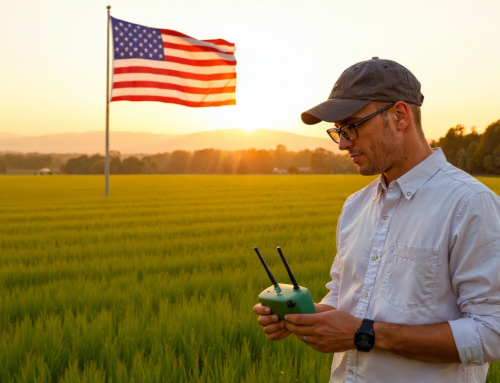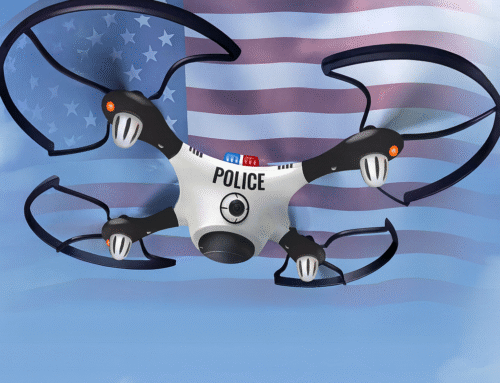DJI’s new Agras T70P is a heavy-duty agricultural drone built to spray crops, spread fertilizer, and even lift loads. It adds to DJI’s long-running Agras lineup, which spans small quadcopters to flagship octocopters. It promises faster coverage, advanced safety, and bigger payloads than before. Let’s look at what it can do and how it compares to earlier models.
DJI Drones in Agriculture
Unmanned aerial vehicles (UAVs) have taken off in farming. These machines treat fields in place of sprayers on trucks or tractors. They reach remote or flooded areas with ease. According to DJI, its drones have sprayed nearly 1.2 billion hectares (about 980 million acres) across 100+ countries.
The Agras T70P (announced July 2025) builds on the earlier Agras T70 (launched in China late 2024). DJI now sells models from small (10–20 kg payloads) to large (100+ kg payloads). The T70P sits near the top of the line. It handles spraying (pesticides, foliar feed), spreading (granular fertilizer), and even lifting payloads, replacing multiple machines on a farm.
DJI’s Agras series carries tens of liters of liquid or hundreds of kilograms of solids. For example, the T70P can carry a 70-liter spray tank or a 100-liter spread tank. It can also lift up to 65 kg of cargo. These are significant numbers. By comparison, the older Agras T50 carries only 40 kg of spray and 50 kg of spread material.
We’ll dig into those differences later. First, let’s see what the T70P itself brings to the field.
Agras T70P Key Specs: Capacity, Speed, and Coverage
DJI designed the T70P for efficiency on large farms. It has a rugged frame with dual-coaxial rotors (two stacked propellers on each arm) for stability. Each rotor can produce up to 70 kg of thrust. The motors drive big carbon-fiber propellers, with a maximum operation speed of 13.8 meters per second (about 49.7 km/h or 30.9 mph). That’s notably fast for a drone of its size. For comparison, the earlier Agras T50 had a top speed of 10 m/s The extra speed means you can cover fields quickly.
The T70P’s payload capacities are impressive. Its main spray tank holds 70 liters of liquid. That is enough pesticide or liquid fertilizer for many acres in one flight. (By contrast, the smaller T50 had a 40-liter tank.) The T70P’s spreader bin holds 100 liters of granular material. This lets it spread solid fertilizer or seed. DJI even includes a cargo hook: the T70P can lift up to 65 kg of weight, turning it into a material transport tool. For instance a farmer could have the T70P drop fertilizer sacks or equipment across a big field or orchard.
How fast can the T70P apply its payload? DJI says the spray system flows at 40 liters per minute. That means the 70L tank empties in roughly 1.75 minutes of full spray. (The T50’s standard dual nozzles gave about 16 L/min, up to 24 L/min with a four-nozzle kite.) In spreading mode, the T70P’s high-flow auger moves up to 400 kg per minute. That’s a massive upgrade from the T50, which topped out at 108 kg per minute (6.5 tonnes per hour). The T70P’s faster flow rates let it cover more ground quickly. Given that the T50 could spray up to 21 hectares (about 50 acres) per hour, the T70P’s larger tank suggests it could exceed that.
Overall, the T70P can boost productivity by as much as 70% over previous models. This is due to the bigger tank and faster speed. In a day of work, you can spray many more acres or complete multi-task jobs without reloading often.
Safety Systems and Autonomy
Flying a 100+ kg drone full of chemicals demands top-notch safety. DJI loads the T70P with advanced sensors. Its Safety System 3.0 includes dual millimeter-wave radars and a vision system. These work together to sense obstacles in all directions. The radars spot large objects (like trees or poles) even in low light or dust. The Tri-Vision system (three cameras) gives visual obstacle detection. Together, they allow the drone to automatically avoid collisions and select safer flight. DJI says the obstacle clearance rates are “significantly improved” with these sensors. For you, that means you can trust the drone to fly under crop canopies or around irregular terrain with less risk of crashing.
In addition to reactive avoidance, the T70P uses intelligent flight planning. You can define a grid or polygon area in software, and the drone will cover it automatically. DJI’s new SmartFarm app helps with this. It provides a map interface where you set waypoints or boundaries. The drone then executes the mission, spraying or spreading as programmed. The app also gives real-time data: you can see coverage progress, battery life, and warnings on your tablet. After a flight, you get reports showing exactly where the spray went, with maps and dosage details. This data helps meet regulations and lets you double-check that no spot was missed.
Another safety feature is terrain following (the T50 already had this, and T70P inherits similar tech). If you’re flying over uneven fields or hills, the drone can maintain a consistent altitude above ground. This ensures even spray distribution and avoids flying too close to the ground. It’s especially useful in orchards or vineyards where the drone flies low between trees.
DJI also stresses data security. By default, flight logs and images stay on your controller until you choose to share them. No data is automatically sent to DJI servers unless you enable that. (In many regions, DJI stores any shared data in local or regional data centers, not necessarily in China.) If you’re concerned about privacy or country-specific regulations, you control how much data gets uploaded.
Related Reading: Chinese Drones Push Back Against U.S. Restrictions
Operational Use: How It Works in the Field
Using the T70P is similar to other DJI Agras drones, so farmers will feel at home. You load the spray liquid (or solid fertilizer) into its tanks, fit any optional nozzles or kits (such as extra sprinklers for orchard work), then plan a flight. You might survey the field by walking or flying a smaller drone first, to map out the area.
For spraying, the drone’s dual-atomization nozzles break the liquid into fine droplets. These droplets can be adjusted in size based on the crop type. For dense canopies, DJI says optional “mist” nozzles can deliver very fine spray. On T100, that system went up to 30 L/min flow on T70P it’s rated 40 L/min, meaning lots of fine spray volume to cover leaves thoroughly. If needed, you could equip a four-sprinkler kit (like the T50’s four nozzles) to boost flow, though DJI hasn’t explicitly said if the T70P supports that. Even with two nozzles at 40 L/min, it’s more than T50’s four at 24 L/min, so it’s quite capable.
For spreading, the auger in the bin feeds out granules evenly. Up to 400 kg can go out every minute, enough to fertilize many hectares quickly. The auger feed rate can be tuned in the app so you hit your target rate (e.g. kg per hectare).
The T70P can also fly in tree crops or orchards. Many fruit farms use DJI drones to spray trees. The T70P’s relatively wide spray swath and adjustable droplet size help treat the tops and sides of trees. The drone’s stability at 20 m/s means it can move fast under tree rows, then slow down with precision if needed. DJI’s “tree spraying kit” (a shroud around the propellers) can be attached for orchard work to reduce drift. The radar and vision allow safe flight among trunks.
Lifting is a less common mode but handy. The T70P’s 65 kg capacity means it could carry spare batteries, equipment, or tools from one part of a field to another. For example, a winemaker might have the drone pick up a sample or carry a bucket to unreachable vines. It’s one more way to make the drone a multi-role machine.
Control is done via DJI’s remote controller with a 7-inch display (as on other Agras models). The bright screen shows telemetry and video feed. During flight, you can switch the mission or make small manual adjustments. It also works with the DJI SmartFarm app on a tablet for pre-planning or after-action reports. Training programs and courses for operators are avilable since flying an agricultural drone safely requires skill.
Related Reading: Drone Courses Online—Get Certified and Start Your High-Paying Career
Comparing the T70P to the Agras T50
The T50 was itself a big step up when it launched in 2024. It carried 40 kg of spray or 50 kg of dry spread, had a 40 L tank (with optional 75 L spread bin), and covered about 50 acres per hour. It flew on two coaxial rotors, with 54-inch props, and had obstacle radars and vision. Its spray flow was up to 16 L/min (single set of nozzles) and 24 L/min with an extra sete. Its battery (30 Ah) and charger let it do 9-min fast charging, so two batteries could alternate.
Now compare the specs:
- Payload: T50 can lift 40 kg (spray) or 50 kg (spread). T70P is rated for 70 kg of spraying, 100 kg of spreading, and 65 kg of cargo. That’s roughly 1.75 times more spray and double the spread capacity. For many farm jobs, this means fewer trips to refill.
- Tank Size: T50 had a 40 L tank (spray) and optional 75 L spread bin. T70P has 70 L spray and 100 L spread.. That bigger volume extends flight time or covers more area per flight.
- Flow Rate: T50 sprayed at 16–24 L/min. T70P sprays at 40 L/min. That is nearly twice as fast, so it can blanket crops faster. For spreading, T50 was 108 kg/min vs T70P at 400 kg/min – almost 4× faster. So even though both drones can carry heavy load, the T70P disperses it much more quickly.
- Battery & Charging: The T50 used the DB1560 battery (30 Ah) with DJI’s 9-minute fast charging generator. The T70P uses higher-capacity batteries (DJI lists DB2100/2160 compatibility). While DJI hasn’t published exact numbers, the T70P’s “ultra-fast charging” suggests it also supports a fast charge with the right charger (e.g. D12000iEP). More importantly, because the drone can carry more, it likely uses a bigger battery to handle the load.
- Size/Weight: The T70P is heavier and larger than the T50. T70P’s takeoff weight (spraying mode) is around 129.5 kg vs the T50’s ~92 kg (including battery). It’s a much larger machine. This means when flying, you must comply with stricter drone weight regulations. It also means more robust controls needed. But from a user’s view, it simply means bigger tasks can be done, albeit with greater operator responsibility.
Regulations and Training: Rules of the Sky
Buying a drone is one thing. Flying it in compliance with law is another. The T70P’s size means operators must follow strict rules. In most countries, heavy agricultural drones fall under special aviation regulations.
For example, in the US FAA Part 137 governs aerial application. To spray pesticides legally, you need both a Part 107 pilot certificate and a Part 137 agricultural aircraft operator certificate. Drones like the T70P (which weigh over 55 lbs) also require a Part 137 exemption to cover the heavier weight. In practice, a farmer or contractor must study for and pass agricultural flight exams, and possibly state certification to spray chemicals. It’s a multi-step process.
Other countries have their own rules. For instance, Brazil now only requires drone registration and a pilot license for farming drones – a simpler approach. Argentina and Spain have also eased rules recently. Many nations are recognizing ag drones as low-risk equipment, similar to ground sprayers. This is good news: easier rules mean faster adoption. But it’s always your responsibility to know local law. In some places, each state or province may have extra pesticide licenses or restrictions.
A trained operator should know how to plan flights, avoid hazards, handle chemicals safely, and respond to emergencies. When you buy a T70P, it’s wise to take such courses or hire a certified contractor.
Additionally, there are airspace rules. Even rural areas may have no-drone zones (like near airports). Before each mission, you must check restrictions and get any necessary clearances. Failure to do so can lead to fines. In general, farmers report that flying over open fields is easier to clear, but edges near villages or infrastructure require caution.
Visit ABJ drone academy for courses on flight planning techniques, safe piloting, and efficiency practices.
Finally, record-keeping is important. Many countries want records of when and where spraying was done. The T70P’s data logging (via the SmartFarm app) can help here. Every flight can be logged with date, time, area covered, and amounts used. That’s useful for farm audits or regulatory compliance.






